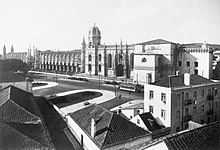Domingos Alvão
Domingos do Espírito Santo Alvão (* 1872 in Porto ; † November 20, 1946 ibid) was a Portuguese photographer. He is one of the most famous Portuguese photographers of the 20th century.
Life
Domingos Alvão was born in 1872 to a middle-class family in the Cedofeita district of Porto. Alvão was interested in photography from an early age and won the German, Porto-based photographer Karl-Emil Biel (in Portugal Emílio Biel) as mentor. After a short internship in Madrid, he began his training as a photographer at Leopoldo Cyrne's photo studio Foto-Velo Clube . At the end of the century he took over the management of the studio and renamed it Escola Práctica de Photographia do Photo-Velo Clube . In this school he founded his photo studio in 1903, which later, in 1926, was also the founding place for his company Alvão e Cia. Lda. was.
Alvão's concern was to create symbioses between works of art and naturalistic, ethnographic documentation. Between 1914 and 1936 Alvão received numerous prizes, including the silver medal at the Leipzig trade fair in 1914 for his participation in the Portuguese stand.

Among other things, Alvão worked as a photographer for numerous companies and institutions in the Portuguese state. Furthermore, numerous journals and magazines, for example Ilustração Portugueza or Gazeta das Aldeias , used his photographs. Among other things, his illustrated book Portugal (1934), which he published, was outstanding . In 1935 he was made Knight of the Order of Christ ( Ordem Militar de Cristo ).
Alvão died of lung cancer in Porto on November 20, 1946 at the age of 74.
Web links
- Further information at unitedphotopress ( Memento from August 28, 2011 in the Internet Archive )
Individual evidence
- ↑ According to other information, 1869
| personal data | |
|---|---|
| SURNAME | Alvão, Domingos |
| ALTERNATIVE NAMES | Alvão, Domingos do Espírito Santo (full name) |
| BRIEF DESCRIPTION | Portuguese photographer |
| DATE OF BIRTH | 1872 |
| PLACE OF BIRTH | postage |
| DATE OF DEATH | November 20, 1946 |
| Place of death | postage |
